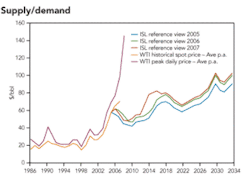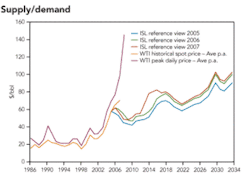How current market turmoil will impact offshore industry
Will Rowley Infield Systems London
The reduction in the price of crude oil to the mid $60s from a high of $147/bbl over such a short period of time has caused many to question its impact, as any drop of close to 50% in its key benchmark must impact any industry. This article examines the effect of such a precipitous decline on current activity and forecast activity within the offshore oil and gas industry.
The key aspect here is to note industry sentiment towards the oil price. I’ve highlighted the word industry to differentiate the inner dealings of the financial community with the reality of decision making in the offshore industry. The inherent conservatism of the majority of the offshore industry has meant that the economic sanction point of the majority of offshore projects is still in the band $40-60/bbl and that this band in itself is only a recent step up from the previous bands of $30-50/bbl and $20-40/bbl.
Most senior executives and directors of E&P companies remember the specter of $10/bbl oil and have resisted the temptation to assume the consistency of $100/bbl oil while accepting that a considerable proportion of the record oil price was a speculative premium. It is also worth noting that for many the prevailing spot price was and still is a distance from the achievable rate of real return. With taxation increasingly skewed towards capping returns on new developments, the majority of the value associated with higher oil prices flows into national coffers rather than corporate ones.
Having praised the insightfulness of many, this is not to accept that the fall in the oil price will have no effect on activity. A fall of this magnitude has and will force many to reconsider their risk profiles as the comfort of a large price differential between sanction hurdle and prevailing price is eroded. This process of re-evaluation will slow the final investment decision of some projects but as of yet we do not foresee any major conventional project facing delays or deferment beyond usual decision-making parameters (most projects have some degree of inherent delay and historically few projects ever get sanctioned on time).
There are some areas of non-conventional activity that may be disproportionately affected by the oil price fall. I use the term non-conventional here to describe projects that are outside the standard and structured decision-making regime of most E&P operators. There is a small proportion of projects that have been fast tracked in order to deliver a return in relation to short-term pricing as well as others that have brought together a variety of partners, including many new or inexperienced investors to exploit an opportunity.
These opportunity projects may have problems if the conventional and inherent conservatism has been outweighed by a short-term financial risk model that assumes a higher oil price. This group is only a relatively small proportion of all projects and in many ways is as likely to be affected by the credit crunch as it is the movement in oil price.
Reducing oil prices is therefore likely to bring the overall number of projects per annum down slightly and reduce capex levels by a similar small degree. But, unless the price falls to much lower levels, a wholesale reappraisal of the industry and projects is not expected.
It is also worth noting that the long lead times associated with most projects means that other than the opportunity projects previously noted, any significant change in itself would require time to work through the highly visible backlog of sanctioned projects.
This brings me to the subject of credit, or lack of, and its potential impact which is expected to be greater than oil price movements in the short term. Most major E&P companies, including international oil companies (IOCs) and national oil companies (NOCs) are cash rich and with a considerable portfolio of long-term sanctioned projects supported by strong cash flows. Any potential reaction to short-term oil price movements are therefore muted and any immediate reaction to credit issues minimized.
The change in oil prices may lead to a period of consolidation where the relative value of the drill-bit versus reduced value shares may change. Already PetroChina has indicated that potential acquisition assets deemed too expensive only a year ago are now valued much less and as such may offer opportunities.
There are real and potential issues relating to credit that are and may continue to impact the wider industry. These can be summarized as:
- Independent project financing
- Investor unbundling
- Contractor asset financing
- Service industry and contractor financing
Recent high oil prices, combined with relatively easily available debt and equity, have allowed a number of independent operators to tap various markets for money to accelerate expansion and target an increasing number of prospective exploration and development opportunities. With oil over $100/bbl and economics based on sub-$50/bbl scenarios, relative rates of return have looked very healthy. Consequently, some operators have either moved ahead with projects using considerable financial leverage and or committed themselves as a partner (participant) within other projects on the basis of assuming high leverage of their respective commitment.
For example, Oilexco recently stated delays in the syndication of debt, and while the company’s strong cash flow instills confidence in the temporary nature of this hold-up, this may just be the beginning. Even a small offshore development can have a price tag of several tens of millions of dollars and even those participants with relative small percentages have a need for capital that can predate its return by many years.
For those operators and partners without strong cash flow and therefore heavily dependent on debt financing, raising all (many have raised initial tranches) of the required capital may be a real problem. Those projects with multiple partners relying on financing may either stall or face increasing delays.
Beyond those companies that are dedicated operators and long–term participants, the past few years has seen an increasing number of participants viewing offshore developments as short-term investment opportunities. Mainly investment or financial funds but also including high net worth individuals, the unbundling of their investments may also serve to destabilize a number of projects and again lead to stall or delays in finding and aligning new partners.
With the expansion of operators and investors, we have witnessed contractors and the service and support industries expand over the past few years. This expansion is necessary to accommodate the expansion of the wider offshore industry, but it has also created a number of highly leveraged companies. This is very evident in relation to the expansion of drilling and marine assets.
Again, expansion has and continues to be necessary, but the balancing of financing and cash has proven difficult for a number of newcomers without the supporting cash flow of existing operations. We have already seen problems with MPU (heavy lifter) and MPF (drilling & production vessel) and we suspect that an increasing number of marine assets in particular will have issues.
The interesting aspects of MPF and identified others are signed contracts with Petrobras that would deliver substantial returns. MPF ran out of money on cost overruns and we surmise another rig provider has decided to conserve cash on two rigs rather than the planned six which may require further financing. Expect to see more rigs and a few construction vessels under construction either change hands or have problems.
The other asset area we suspect may have some issues is small- to mid-size FPSOs and in particular those associated with independents and in Asia. There are indications that the Crux FPSO may be having issues. With vessel financing alone combining with independents and many investor partners these types of projects may suffer from a multitude of financing issues.
The fourth and final area of concern relates to the expansion of the service industry and the increasing involvement of private equity and debt expansion. While taking a positive view on the involvement of private equity within the offshore industry, problems with investments elsewhere in some company portfolios may hasten a selling of some stakes and a reduction in investment activity in new opportunities.
Geographic expansion has been a substantial theme for many of the industry’s service and support companies, much funded through debt expansion. Further expansion is likely to be curtailed in the short term and this may put pressure on certain supply chains that have planned on such an expansion.
In the short term, we expect this final area to suffer from the same hiatus as the general market but then see a number of opportunities for larger companies to make acquisitions at more realistic rates than the past few years.
In summary, the sharp decline in oil prices is not a surprise and in itself is not a medium- or long-term concern and arguably the removal of degrees of speculation may prove to be a good thing. The credit crunch is a different matter, with independent operators in particular being squeezed, some investors unbundling their investments, some assets having problems (including some FPSOs) and expansion plans curtailed. The consequence of all of this is that some projects may be deferred and put back on the shelf pending sale or change and others are likely to face extended delays (even beyond supply-related delays of recent history).
In the main though, we expect most mid-to large-size projects to continue with the majority of underlying activity already past sanction or investment decision points. We expect the recent industry frenzy to calm down to more sustainable levels and even with a slowdown in demand-driven growth, the simple aspect of depletion and increasingly complex replacement reserves and production means that the industry will continue to demand higher levels of activity than before.
About the author
Will Rowley [[email protected]] is director of analytical services for UK-based Infield Systems Limited [www.infieldlive.com]. He has formal training in business and law and previous experience at Total and the University of Kent and has spent more than 10 years undertaking strategic and market analysis within the offshore industry.


